
|
|
13 July, 2004
Today I began some of my work helping to collect and process water samples.
At the beginning of the cruise, we ran two CTD lines (see the map below and
look for the red dots outside of Kodiak and toward the end of the Aleutian
Island chain where we turned north). Others took water from those, but we
began to take samples today from the Bering Sea line. The "we" includes Ari
Balsom, Rebecca Pirtle-Levy, Alicia Clark and me. At each station, we took
samples for oxygen 18, nutrients, and chlorophyll. The CTD rosette is a
ring of 12 bottles set to collect water at different depths. At some
stations, we took water from all the bottles, and at some stations we took
only selected depths. The tiny amounts of water we take for oxygen-18 will
be returned to the University of Tennessee for analysis. Oxygen-18 used to
trace the origin of the water to tell if it is from fresh water or salt.
It takes a bit more time to process the water samples for chlorophyll.
(Note: we'll also gather mud samples later on for chlorophyll analysis.)
The amount of chlorophyll present is an indicator of the productivity (food
availability) since chlorophyll is present in the phytoplankton, the tiny
plants that use photosynthesis to produce food. Each of these samples must
be kept in the dark as much as possible so photo (light) synthesis is shut
down. Once filtered, they are kept in the freezer for one hour to burst the
chloroplasts (the tiny structures inside plant cells that hold the
chlorophyll). The addition of acetone at the end of an hour releases all
the pigments and the samples can then be incubated for 24 hours. At the
end, they are "read" with a fluorometer to find the amount of chlorophyll-a
in each sample.
The nutrient samples are the easiest. They are only taken from the surface,
bottom and the area of maximum chlorophyll. They are then frozen and sent to
a lab in Santa Barbara, California for analysis of the various nutrients
present.
This is my second cruise with Ari Balsom, research coordinator from the
University of Tennessee. Ari and Rebecca Pyrtle-Levy, a graduate student in
ecology and evolutionary biology at the University of Tennessee, came to the
Laurier after a 6 week spring cruise on the USCGC Healy. And, once this
cruise has ended, they will return to the Healy for another 6 week cruise!
Alicia Clark, an undergraduate in ecology and evolutionary biology from the
University of Tennessee, is on her first cruise. Both Rebecca and Alicia
are working on projects of their own which I'll tell you about in a future
journal.
Since this is a short cruise, I won't have time to tell you about all the
interesting aspects of the Sir Wilfrid Laurier, but I'll try to add a little
to my journal each day. One thing that always seems to be a morale booster
is good food, and the Laurier has it in abundance thanks to the cooks, Herb
(desserts) and Harold (main meal). Herb Lynch is from Fogo Island,
Newfoundland, and Harold Steed is from Surrey, British Columbia. Between
them, they turn out gourmet meals three times a day and add home made snacks
for those who still get the munchies in between. Right now, they're cooking
for the 43 members of the crew and science team on board. The ship stores
provisions for 12 weeks at a time, although fresh produce is brought on
board when the crew changes after 6 weeks. According to Harold, the low
carb craze has even taken hold on board the ship where only a quarter of the
crew eats potatoes, and the favorite meal is steak. There's no question
that mealtimes are popular on board the Laurier!
--
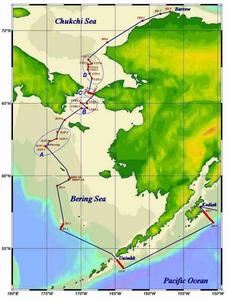
Cruise plan for our science work (courtesy of Bon van Hardenberg, chief scientist) --
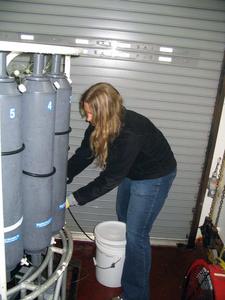
Ari Balsom collecting water from the CTD bottle rosette. --
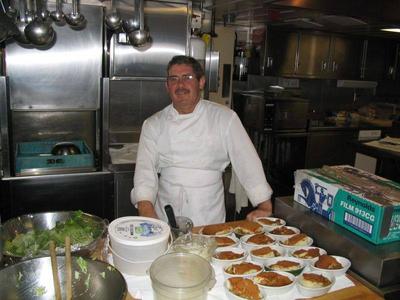
Herb Lynch's desserts are the best! --
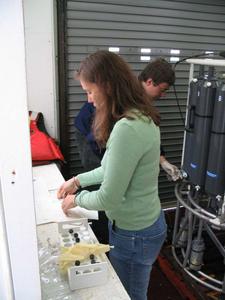
Rebecca Pirtle-Levy is getting sample bottles ready to draw water from the CTD. --

Alicia Clark waiting to get water from the CTD bottles. --
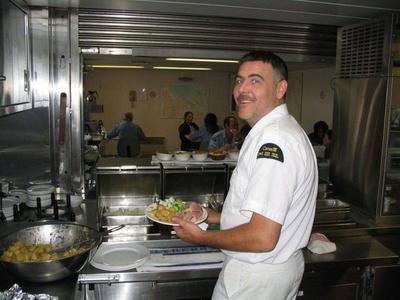
Harold Steed keeps everyone happy with his gourmet meals! --
Contact the TEA in the field at
.
If you cannot connect through your browser, copy the
TEA's e-mail address in the "To:" line of
your favorite e-mail package.
|
